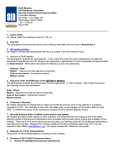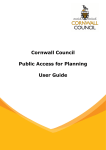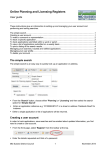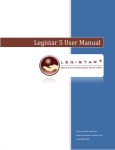Download Newcastle Planning Online Services User Guide
Transcript
Newcastle Planning Online Services User Guide > Registering with us > Searching for Applications > Viewing Application details > Submitting comments Newcastle City Council – Planning Online User Guide Page 2 of 22 Newcastle City Council – Planning Online User Guide Registering Anyone can use the site to view planning applications, but to take advantage of the advanced profile features that allow you to save searches and track applications you must first register a user account. 1. To create a new user account click on Register in the menu bar. Figure 1 - Registering your details 2. Register your personal details by filling in the following fields: • Title – select the title you wish to be addressed by • First Name – enter your first name • Surname – enter your surname. • Email Address – enter your email address. Enter it again to confirm that it is correct. Page 3 of 22 Newcastle City Council – Planning Online User Guide • Password – enter a password that will allow only you to access your account. Repeat it in the box below. Note: Passwords must be five characters or longer and may not contain spaces. Enter the password again below to confirm that it is correct. 3. Click to read the Terms and Conditions and Privacy Policy that apply to the use of this site. When you have done so tick the check box to indicate that you agree to them. 4. When you have entered your personal and login details, click on the Register button. 5. An email will be sent to the address you entered. This provides final confirmation that you want to create a Planning Online account. When the email arrives, click on the link to be returned to the Planning Online site. Page 4 of 22 Newcastle City Council – Planning Online User Guide Searching Your primary activity when you are logged in to the Planning Online site will be to search for applications according to a variety of criteria. The site provides a variety of methods to allow you to find the information you are looking for. 1. Search methods include: • Simple search – search for applications, appeals or enforcements according to some entered text • Advanced search – search according to a wide combination of factors • Map search – search using an interactive map tool • Property search – search for a particular property to which applications may apply • Weekly/monthly lists – search for applications whose status is validated or decided within a particular time period. Simple Search A simple search allows you to search quickly for an application, appeal or enforcement by entering some text that will help identify the application. 2. Select Simple Search from the Search drop down list. Figure 2 - Carrying out a Simple Search Page 5 of 22 Newcastle City Council – Planning Online User Guide 6. 7. 8. Click to select whether you want to search for: • Applications • Appeals • Enforcements. Enter some text in the Search box that will correspond to one of: • Application reference number (for example, “2009/0001/01/DET”) • Post code (for example, “NE1 8PH”) • Part of an address (for example, “Civic Centre”, “High Street”) • Keyword (for example, “first floor extension”, “A3”) Click on the Search button to display the results of your search. Figure 3 –I- Search results Page 6 of 22 Newcastle City Council – Planning Online User Guide 9. You can manipulate the how the search results are displayed to help you find applications of particular interest: • • • Sort By – select a criterion to re-order the results by Direction – choose whether the results should be displayed in ascending or descending order Results per page – choose how many results should be displayed on the page at once. Once you have made your display selections, click on the Go button. 10. The number of results being displayed (out of the total number of results) is shown. If there are more results than fit on to one page you can navigate between the results pages either by clicking on Next to view the next page or by clicking directly on the page number 11. A map of the relevant area is displayed. Click on Show results on large map to see the locations of the search results in more detail (see Map Search). 12. To view a search in detail, click on its title. 13. If there are too many results, or if the results do not contain the applications you are looking for, you can go back to the search by and amend your search criteria. To do this, click on the Refine Search button. 14. If this search is one that you will reuse, click on the Save Search button. You can edit the search name here and select whether to receive an email if new applications arrive that match the search criteria. Click on Save to save the search. This search will appear in your Saved Searches page (see Saved Searches). From there it can be run as often as you like, or edited and updated at any time. 15. To display the current page of search results in a printable format, click on the Print button. Figure 4 –I- Printing your search results Page 7 of 22 Newcastle City Council – Planning Online User Guide Click Print again in the new window to send the page to your local printer. Press Close when you are finished with this window. Advanced Searching An advanced search allows you to build a complex combination of specific criteria on which to search for an application, appeal or enforcement. These may include: • Application reference numbers • Application/Appeal/Enforcement details • Relevant / Key Dates (including date ranges) 1. Select Advanced Search from the Search drop down list. Figure 5 –I- Advanced search screen 2. Click to display a search page specific to: • Applications • Appeals • Enforcements. Page 8 of 22 Newcastle City Council – Planning Online User Guide 3. If you know a reference number that identifies a specific application enter it in the appropriate box. 4. The Application/Appeals/Enforcement details allow you to specify an application type, status or decision as well as location details, which include ward, parish and address information. Enter any combination of these details as appropriate. 5. Click on the Search button to display the results of your search. Figure 6 –I- Advanced search results screen 6. You can manipulate the how the search results are displayed to help you find applications of particular interest: • Sort By – select a criterion to re-order the results by • Direction – choose whether the results should be displayed in ascending or descending order • Results per page – choose how many results should be displayed on the page at once. Once you have made your display selections, click on the Go button. 7. The number of results being displayed (out of the total number of results) is shown. If there are more results than fit on to one page you can navigate between the results Page 9 of 22 Newcastle City Council – Planning Online User Guide pages either by clicking on Next to view the next page or by clicking directly on the page number. 8. A map of the relevant area is displayed. Click on Show results on large map to see the locations of the search results in more detail (see Map Search). 9. To view a search in detail, click on its title. 10. If there are too many results, or if the results do not contain the applications you are looking for, you can go back to the search by and amend your search criteria. To do this, click on the Refine Search button. 11. If this search is one that you will reuse, click on the Save Search button. This search will appear in your Saved Searches page (see Saved Searches). From there it can be run as often as you like, or edited and updated at any time. 12. To display the current page of search results in a printable format, click on the Print button. Figure 7 –I- Printing your search results Click Print again in the new window to send the page to your local printer. Press Close when you are finished with this window. Page 10 of 22 Newcastle City Council – Planning Online User Guide Map Searching Note This feature is only recommended for broadband users. The Map Search feature allows you to identify applications using an interactive map. 1. If the interactive map is not displayed, click on the Map Search tab. Figure 7 –I- Map search screen 2. Select what you want to search for: • • • • Applications – shown as green dots Appeals – shown as red dots Enforcements – shown as yellow dots Properties – shown as grey dots. 3. Select the time period during which applications have been actioned. 4. The interactive map contains a number of tools to help you zoom in and locate the desired addresses: • • Page 11 of 22 Initial map view – click this to zoom the map out to show the widest possible view Zoom in – select this tool then click a point on the map that you want to zoom in to Newcastle City Council – Planning Online User Guide • • • • • • • • 5. Zoom out – select this tool then click on the map to zoom out Zoom Slider – move the slider up to zoom in; down to zoom out Pan mode – to move around the map, select this then click on the map. Keeping the mouse button depressed, drag the cursor in the direction that you want to pan Pan arrows – click on the up, down, left or right arrows to pan the view in the selected direction Zoom to rectangle – to zoom in on a selected area, select this tool then click and drag the cursor to draw an area on the map Previous view – to return to the previous view, click on this tool Next view – when you have used the Previous view tool, click on this button to go to the view that followed the one that is currently displayed Map area – displays the dimensions of the area displayed by the map. Use these tools to display a map area that contains one or more dots identifying properties of interest. Figure 7 –I- Map search screen Hover the cursor over one of the identifying dots to display the reference number for that application. 6. The applications shown on the map are listed by reference number to the right. To open one of these, click on it. Page 12 of 22 Newcastle City Council – Planning Online User Guide 7. 8. Alternatively you can display the applications on the map as a search results list. To do this, click on Show Results as a List. • You can print off this list by clicking on the Print button. • The application locations are displayed on a Small Map on the right. You can return to the original map by clicking on Show results on large map. You can add a map search to your Saved Searches list in one of two formats: • Save Map Extents Search – click on this to save the search, incorporating all of the applications shown on the map • Save Proximity Search – select a proximity distance, then click on this to save the search, incorporating all of the applications within the selected distance. Property Search The Property Search feature allows you to search for a specific property. There are two options: • • • Alphabetical Street Search – search for applications on a specified street chosen from an alphabetical list Address Search – search for applications at a specified address. Alphabetical Property Search 1. Click on the Property Search tab. 2. To search for a street alphabetically, select Alphabetical Street Search. Figure 8: A to Z Property Search Page 13 of 22 Newcastle City Council – Planning Online User Guide 3. Click on the initial letter of the street you are interested in. Select from the list to display the addresses on that street that have an application in progress. Figure 9: Property Search Results • To change the direction of the list select Ascending or Descending from the Direction drop down list, followed by Go. • To change the number of results displayed, select from the Results per page drop down list, followed by Go. • If there are more results than fit on one page, navigate to further pages by clicking on Next or by clicking on the Page Number directly. 4. You can print off this list by clicking on the Print button. 5. The application locations are displayed on a Small Map on the right. You can display a larger map by clicking on Show results on large map. 6. To go back and chose a different street, click on the Refine Search button. Page 14 of 22 Newcastle City Council – Planning Online User Guide Address Search 1. Click on the Property Search tab. 2. To search for a specific property by its address, select the Address Search tab. Figure 10: Custom Address Search 3. Enter as many details as you know in the appropriate boxes, then click on the Search button. Alternatively, click on the Reset button to clear the fields and start again. Figure 11: Results for a Property Search Page 15 of 22 Newcastle City Council – Planning Online User Guide • • • To change the direction of the list select Ascending or Descending from the Direction drop down list, followed by Go. To change the number of results displayed, select from the Results per page drop down list, followed by Go. If there are more results than fit on one page, navigate to further pages by clicking on Next or by clicking on the Page Number directly. 4. To add this search to your Saved Searches page, click on the Save Search button. 5. You can print off this list by clicking on the Print button. 6. The application locations are displayed on a Small Map on the right. You can display a larger map by clicking on Show results on large map. 7. If there are too many results you may want to add more information to the Search. Click on the Refine Search button to go to the Advanced Search tab. Weekly/Monthly Lists Search The Weekly/Monthly Lists feature allows you to search for applications according to the week or month in which they were validated or decided. 1. Click on the Weekly/Monthly Lists tab. Figure 12: Weekly / Monthly List Search Page 16 of 22 Newcastle City Council – Planning Online User Guide 2. Click on Weekly List or Monthly List to select which list you want to search. 3. Select the application status from the Status drop down list. 4. Select the Week or Month from the drop down list. 5. You can display either applications which are validated or decided during this time period. Make the appropriate selection under Show applications. 6. When you have made your selections, click on the Search button. Figure 13: Results for Weekly / Monthly List • • • • • You can re-order the list by reference number, date received, description or status. Select one of these from the Sort by drop down list, then click on Go. To change the direction of the list select Ascending or Descending from the Direction drop down list, followed by Go. To change the number of results displayed, select from the Results per page drop down list, followed by Go. If there are more results than fit on one page, navigate to further pages by clicking on Next or by clicking on the Page Number directly. 7. To add this search to your Saved Searches page, click on the Save Search button. 8. You can print off this list by clicking on the Print button. 9. The application locations are displayed on a Small Map on the right. You can display a larger map by clicking on Show results on large map. Page 17 of 22 Newcastle City Council – Planning Online User Guide 10. If there are too many results you may want to add more information to the Search. Click on the Refine Search button to go to the Advanced Search tab. Page 18 of 22 Newcastle City Council – Planning Online User Guide Viewing Details of the Application Once you have selected an application from your search results the application’s details will be displayed. Figure 14: Viewing details of the application The application details are displayed at the top of the page and the tabs below it contain all of the relevant information about the application. Details include: • • • • • • Details – Description of the proposal, applicant / agent details, key dates and contact details. Comments – Displays both statutory and public comments held by the system. Constraints – Displays constraints affecting the property (for example: whether it is in a conservation area, is it affected by a Tree Preservation Order (TPO)) Documents – Lists documents associated with the application (application form, plan drawings, supporting information, public comments etc.) Related Items – Displays any other planning related property information held by the Council (Planning appeals, Enforcement enquiries, other Planning applications etc.) Map – Shows the location of the proposal on the map. Page 19 of 22 Newcastle City Council – Planning Online User Guide Figure 15: List of associated documents Page 20 of 22 Newcastle City Council – Planning Online User Guide Commenting on an Application To submit a comment on an application you firstly need to Register / Login 1. To add a comment to the list, click on Make a Comment. 2. Some details are entered automatically based on the information you submitted when you registered on the site. • • • 3. Your name Address Contact details In addition you will need to enter the following: • Commentor Type drop down list describes the type of people who may need to make a comment about an application. These include councilors, neighbours to the application address and members of the public. Select the one that applies to you. • Reason for comment box select one or more of the offered reasons for making your comment. • Enter the details of your comment in the Your Comment box. • If you want to receive an email confirming that your comment has been received, check the Send me an email confirming my comments box. • When you have completed all the details, click on the Submit button. • Your comment will appear in the Comments page for this application and a record will be uploaded automatically to the Documents section of the site. Note: All comments will be filed on the application file and will be available for public viewing as well as being immediately available on our website. Page 21 of 22 Newcastle City Council – Planning Online User Guide Figure 16: Sample comments screen Page 22 of 22
































